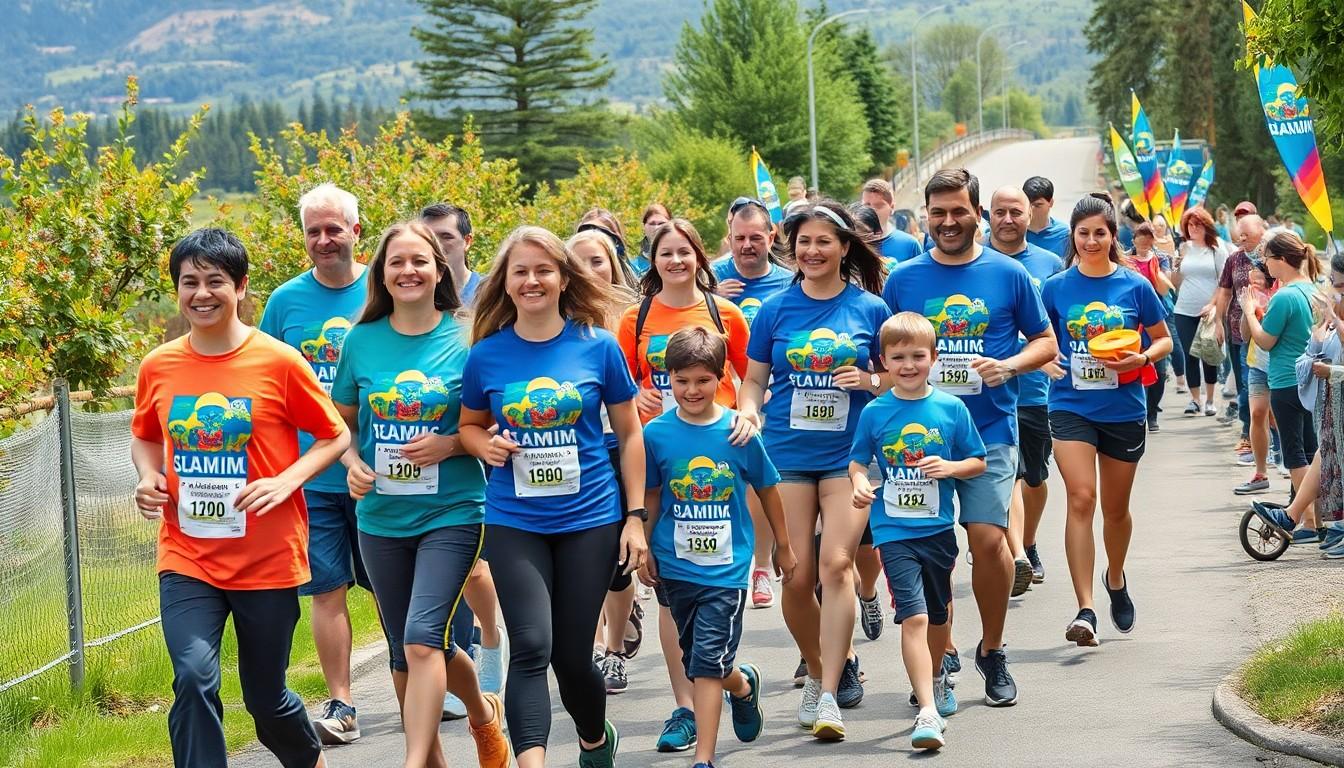Table of Contents
ToggleWalking for a cause transforms ordinary steps into extraordinary impact. Charity walking events have become increasingly popular ways for people to make a difference while staying active. These heartwarming gatherings bring communities together creating ripples of positive change one step at a time.
From 5K walkathons to multi-day treks these events raise millions of dollars annually for various causes including medical research disaster relief and education initiatives. Participants don’t need to be marathon runners or fitness experts – just caring individuals ready to lace up their shoes and join the movement. The beauty of charity walks lies in their inclusive nature welcoming everyone from toddlers to grandparents making it a true family affair.
What Are Charity Walking Events
Charity walking events bring communities together through organized walking activities that generate funds for specific causes. These structured fundraising initiatives combine physical activity with philanthropic goals to create meaningful impact.
Types of Charity Walks
- Memorial walks honor individuals or groups while raising awareness for specific conditions like cancer or heart disease
- Challenge walks span multiple days covering extensive distances of 50+ miles
- Virtual walks enable remote participation through GPS tracking apps worldwide
- Family fun walks incorporate entertainment activities suitable for children ages 5-12
- Themed walks feature costume contests seasonal decorations holiday music
- Walkathons set specific distance goals ranging from 5K to marathon length
- Nature walks combine environmental education with charitable fundraising
How These Events Support Causes
Organizations receive direct financial support through:
- Registration fees ranging from $25-100 per participant
- Pledge-based fundraising with participants collecting sponsor donations
- Corporate matching programs doubling individual contributions
- Event merchandise sales including t-shirts water bottles caps
- On-site vendor partnerships sharing percentage of sales revenue
- Photo packages capturing participant milestone moments
- Mobile donation stations processing instant card payments
- Medical research programs at leading institutions
- Community outreach services for underserved populations
- Educational scholarships for qualifying students
- Emergency relief efforts during natural disasters
- Animal welfare initiatives at local shelters
Planning Your First Charity Walk
Participating in a charity walk starts with careful planning to ensure a successful fundraising experience. Strategic preparation enhances both fundraising potential and physical readiness for the event.
Choosing the Right Event
First-time charity walkers evaluate events based on distance, cause alignment and personal fitness level. Local events offer convenience with distances ranging from 3 to 5 kilometers for beginners. Regional walks support causes like cancer research, children’s hospitals or animal shelters through established organizations with proven track records. Registration deadlines occur 4-8 weeks before event day with early bird discounts cutting fees by 25-40%. Popular spring and fall events fill up 2-3 months in advance due to ideal walking temperatures between 55-75°F. Virtual charity walks provide flexible alternatives with customizable routes, timeframes and fundraising goals.
Training and Preparation Tips
A structured 8-week training program builds endurance through progressive distance increases. Beginning walkers start with 15-minute sessions 3 times per week, adding 5 minutes weekly until reaching event distance. Breaking in walking shoes requires 20-30 miles of wear before event day. Hydration starts 24 hours pre-event with 2-3 liters of water daily. Training walks match event start times to acclimate the body to specific weather conditions. Equipment includes moisture-wicking clothing, anti-blister socks, sun protection rated SPF 30+ and a hands-free water bottle. Rest days between training sessions allow muscle recovery while preventing overuse injuries.
Fundraising Strategies for Walkers
Successful fundraising for charity walks combines digital tools with personalized outreach methods to maximize donations. Effective strategies help walkers surpass their fundraising targets while engaging supporters meaningfully.
Setting Up Online Donations
Online fundraising platforms streamline the donation process for charity walks through dedicated participant pages. Popular platforms like JustGiving GoFundMe offer automated receipt generation mobile-friendly interfaces secure payment processing. Walkers customize their fundraising pages with personal stories photos progress trackers to connect with donors emotionally. Integration with social media channels expands reach allowing supporters to share donation links across multiple platforms. These digital tools track contributions in real-time display fundraising thermometers motivate donors through transparency.
Creative Ways to Meet Goals
Matching gift programs double donations when employers contribute equal amounts to employee fundraising efforts. Social media challenges create engagement through themed content like step counting contests progress updates live streaming training sessions. Email campaigns segment donor lists target messages based on giving history relationship strength past involvement. Fundraising events complement online efforts through bake sales garage sales fitness classes workplace donation drives. Corporate sponsorships provide substantial support when walkers approach local businesses with structured sponsorship packages promotional opportunities. Mini-challenges break larger goals into achievable milestones rewarding donors with personal thank you videos social media shoutouts milestone celebrations.
Benefits of Participating
Charity walking events create positive outcomes for both participants and beneficiaries. These events combine physical activity with social impact, generating multiple advantages for those who take part.
Physical and Mental Health Impact
Regular walking during training and events improves cardiovascular health with 30-45 minutes of sustained activity. Participants experience enhanced muscle strength particularly in legs calves knees when covering distances of 3-5 miles per session. The endorphin release during walking reduces stress levels by 25-30% according to fitness tracking data from major charity walks. Studies show participants sleep 15% better during training periods due to increased physical activity. Walking outdoors exposes participants to vitamin D which strengthens immune system function by 20%. The combination of exercise goal-setting achievements releases dopamine creating lasting mood improvements.
| Health Benefit | Impact |
|---|---|
| Stress Reduction | 25-30% |
| Sleep Quality | +15% |
| Immune Function | +20% |
Building Community Connections
Charity walks foster meaningful relationships through shared training sessions team activities group fundraising. Participants connect with 15-20 new people on average during pre-event meetups training walks. Local walking groups form lasting bonds with 80% maintaining contact after events conclude. Corporate teams strengthen workplace relationships as 90% report improved colleague interactions. Social media groups for specific charity walks create year-round communities with 5000+ active members. Multi-generational participation brings families together with 3-4 family members typically joining single teams. Cultural exchange occurs naturally as walks attract participants from 12-15 different community groups.
| Connection Type | Average Impact |
|---|---|
| New Connections | 15-20 people |
| Team Retention | 80% |
| Family Participation | 3-4 members |
Safety and Logistics
Safety protocols ensure participants’ well-being during charity walking events through proper preparation guidelines. Event organizers maintain strict safety measures including medical stations placed at 2-mile intervals along routes.
What to Bring on Walk Day
Essential items for charity walks include:
- Comfortable walking shoes with 300-500 miles of prior wear
- Two pairs of moisture-wicking socks to prevent blisters
- Water bottle holding 24-32 ounces of fluid
- Energy snacks containing 100-200 calories per serving
- Basic first aid supplies (bandages, antiseptic wipes, blister pads)
- Photo ID plus emergency contact information
- Mobile phone with portable charger
- Small backpack or fanny pack for supplies
- Sunscreen with SPF 30+ protection
- Hat or visor for sun protection
- Event registration confirmation
- Cash for vendor purchases or donations
Weather Considerations
Weather impacts charity walks through varying temperature conditions:
| Weather Type | Temperature Range | Required Items |
|---|---|---|
| Hot Weather | Above 80°F | Light clothing, extra water |
| Mild Weather | 60-80°F | Layered clothing |
| Cold Weather | Below 60°F | Thermal wear, gloves |
Participants monitor weather forecasts 48 hours before event day. Morning events start earlier during summer months to avoid peak temperatures. Rain protocols include waterproof gear or event rescheduling based on severity. Lightning triggers automatic event postponement for participant safety.
Conclusion
Charity walking events stand as powerful vehicles for positive change combining physical wellness with meaningful social impact. These accessible events create lasting connections while generating vital support for numerous worthy causes.
Whether someone’s joining their first 5K or organizing a multi-day trek the transformative effects reach far beyond the miles covered. Through careful preparation proper training and strategic fundraising participants can maximize their impact while enjoying the numerous health and social benefits these events provide.
The growing popularity of charity walks reflects their unique ability to unite communities create lasting change and inspire others to take those first steps toward making a difference. With each step taken participants move closer to both personal achievement and collective social good.





